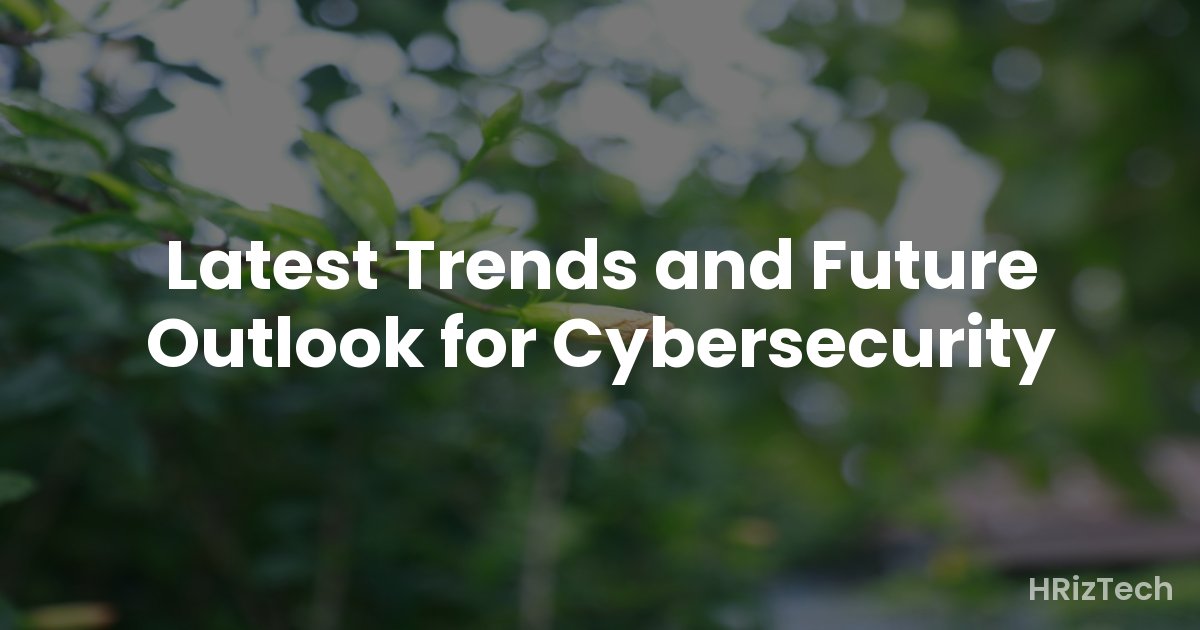Latest Trends and Future Outlook for Cybersecurity

Latest Trends and Future Outlook for Cybersecurity
- AI and machine learning are revolutionizing threat detection and response.
- The rise of the Metaverse presents unique cybersecurity challenges.
- Zero Trust architecture is becoming increasingly crucial.
- The skills gap in cybersecurity remains a significant concern.
- Quantum computing poses both threats and opportunities for cybersecurity.
The Evolving Threat Landscape
The cybersecurity landscape is in constant flux, with new threats emerging daily. Traditional methods of protection are often insufficient to counter sophisticated attacks leveraging AI, automation, and increasingly complex social engineering techniques. Cybercriminals are becoming more organized and well-funded, targeting both large corporations and individuals with devastating consequences. Ransomware attacks, data breaches, and phishing scams continue to plague organizations worldwide, resulting in significant financial losses and reputational damage.
AI and Machine Learning in Cybersecurity
Artificial intelligence (AI) and machine learning (ML) are rapidly transforming the cybersecurity industry. These technologies offer the potential to automate threat detection, analyze vast amounts of data to identify anomalies, and predict potential attacks before they occur. AI-powered security solutions can analyze network traffic, identify malicious code, and detect suspicious user behavior far more efficiently than human analysts alone. However, it's crucial to understand that AI is not a silver bullet. Adversaries are also leveraging AI to create more sophisticated and evasive attacks, leading to an ongoing arms race.
The Rise of the Metaverse and its Security Implications
The Metaverse, a persistent, shared, 3D virtual world, presents a new frontier for cybersecurity. As more individuals and businesses migrate to these virtual spaces, the potential for new types of cyberattacks increases dramatically. Data breaches, identity theft, and virtual harassment are just a few of the threats that Metaverse users face. Securing these virtual environments requires a multi-layered approach, combining traditional cybersecurity measures with new technologies designed to protect users and their digital assets within the Metaverse.
Key Security Architectures and Strategies
Zero Trust Architecture: A Paradigm Shift
The traditional "castle-and-moat" approach to security, where a perimeter is defended, is increasingly inadequate. Zero Trust architecture represents a fundamental shift in security philosophy. It assumes no implicit trust and verifies every user, device, and application before granting access to resources. This approach relies on continuous authentication, micro-segmentation, and robust access control mechanisms to minimize the impact of breaches. Implementing Zero Trust requires a significant investment in infrastructure and expertise, but the benefits in terms of enhanced security are substantial.
The Importance of Enhanced Authentication
Strong authentication methods are crucial to preventing unauthorized access. Multi-factor authentication (MFA), which requires users to provide multiple forms of authentication, significantly reduces the risk of successful attacks. Beyond MFA, biometrics, passwordless authentication, and behavioral analytics are also gaining traction as more robust and user-friendly alternatives to traditional password-based systems. These advancements enhance security while improving user experience.
The Human Element and the Skills Gap
Despite technological advancements, the human element remains a critical factor in cybersecurity. Phishing attacks, social engineering, and insider threats continue to be significant vulnerabilities. Investing in security awareness training for employees is crucial to mitigate these risks. However, a significant skills gap exists in the cybersecurity industry, making it challenging for organizations to find and retain qualified professionals. This shortage exacerbates existing vulnerabilities and hinders the effective implementation of security measures.
The Impact of Quantum Computing
Quantum computing, while still in its early stages, poses both threats and opportunities for cybersecurity. Quantum computers have the potential to break widely used encryption algorithms, rendering current security measures obsolete. This necessitates the development of new, quantum-resistant cryptographic techniques to protect sensitive data in the future. However, quantum computing also offers potential benefits for cybersecurity, enabling the development of more powerful threat detection and response systems.
Practical PHP Snippets
Here are two simple PHP snippets illustrating secure practices:
// Secure password hashing using password_hash()
$password = $_POST['password'];
$hashed_password = password_hash($password, PASSWORD_DEFAULT);
//Store $hashed_password in your database. Never store passwords in plain text.
//Example of parameterized SQL query to prevent SQL injection
$username = $_POST['username'];
$stmt = $pdo->prepare("SELECT * FROM users WHERE username = ?");
$stmt->execute([$username]);
$user = $stmt->fetch();
Remember to always sanitize user inputs and use parameterized queries to prevent SQL injection vulnerabilities.
The Future of Cybersecurity
The future of cybersecurity will be defined by the ongoing arms race between attackers and defenders. AI, machine learning, and quantum computing will play increasingly crucial roles, shaping both the nature of threats and the methods used to counter them. A holistic approach, combining technological advancements with a strong focus on human factors and robust security practices, will be essential to navigate the evolving threat landscape. The skills gap must be addressed through education and training initiatives to ensure a sufficient workforce capable of protecting critical infrastructure and sensitive data.
Key Takeaways
The ongoing evolution of cyber threats necessitates a proactive and adaptive approach to cybersecurity. Organizations must embrace new technologies, invest in skilled professionals, and prioritize security awareness training to effectively protect themselves in this ever-changing landscape.
What are your biggest concerns regarding the future of cybersecurity, and what strategies do you believe are most effective in mitigating these risks?
Comments
No comments yet. Be the first to comment!